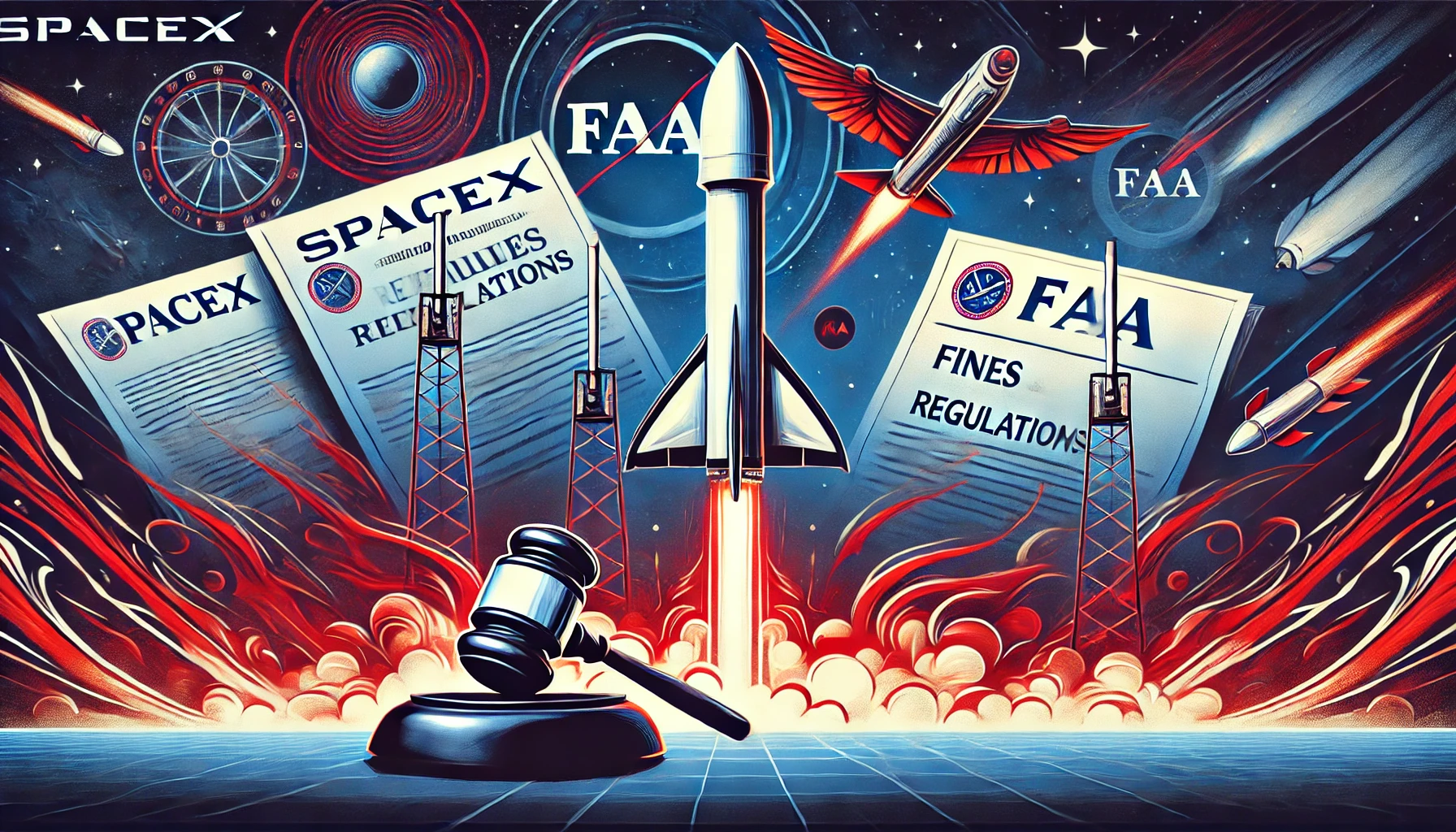SpaceX’s Legal Battle with the FAA: A Breakdown of Fines, Violations, and the Future of Commercial Space Regulation
The ongoing regulatory battle between SpaceX and the Federal Aviation Administration (FAA) has become a hot topic in the aerospace world, with potential implications for the entire commercial space industry. In recent years, SpaceX has faced increasing scrutiny from the FAA, leading to fines, delays in launch approvals, and mounting frustrations from both sides. This tension came to a head in 2024 when SpaceX blasted the FAA’s proposed fines in a complaint letter to Congress. The dispute touches on regulatory inefficiencies, safety concerns, and the future of U.S. spaceflight. Here, we explore the key issues, fines, and violations behind this conflict.
SpaceX FAA Fines: What Led to the Dispute?
In September 2024, the FAA proposed fines of $633,009 against SpaceX, citing violations during two major launches in 2023. These included a Falcon 9 mission involving the Indonesian SATRIA satellite and a Falcon Heavy launch of the EchoStar Jupiter 3 satellite. The FAA’s accusations centered around the company’s failure to comply with certain launch licensing requirements, including the use of a new launch control room and an unapproved propellant farm.
The SpaceX FAA fines triggered a broader conversation on the regulatory obstacles that the commercial spaceflight industry faces. SpaceX claimed that the FAA’s actions were unnecessary and even detrimental to the progress of U.S. space innovation.
FAA SpaceX Violations: The Key Allegations
The FAA accused SpaceX of two key violations:
- Unauthorized Launch Control Room: For the PSN SATRIA Falcon 9 launch, SpaceX used a new launch control room that had not been approved by the FAA. Despite notifying the FAA in advance, the agency had not completed its review before the launch, leading to one of the primary violations.
- RP-1 Propellant Farm for Falcon Heavy: For the EchoStar Jupiter 3 launch, SpaceX employed a new RP-1 propellant farm that had also not received FAA approval. However, SpaceX maintains that the new location was chosen to improve safety, a fact later confirmed by federal safety authorities. Despite this, the FAA levied fines for the company’s use of the farm without prior clearance.
These FAA SpaceX violations have drawn sharp criticism from SpaceX, which argues that the agency’s processes are outdated and slow-moving, failing to keep pace with the rapidly evolving commercial space industry.
SpaceX Regulatory Issues: A Systemic Problem?
Beyond the specific FAA fines and violations, SpaceX’s frustrations run much deeper. In a detailed letter sent to Congress, the company outlined broader systemic issues within the FAA, particularly its Office of Commercial Space Transportation (AST). According to SpaceX, the AST lacks the necessary resources and flexibility to review and approve licenses in a timely manner, leading to unnecessary delays.
These SpaceX regulatory issues have real-world consequences. For instance, the company has been ready to launch its Starship vehicle for months, but the FAA has delayed approval, citing environmental review concerns. The delays not only hinder SpaceX’s operations but also impact the broader goals of U.S. government agencies that rely on commercial space capabilities for national security and scientific exploration.
SpaceX Congress Complaint: Seeking Legislative Support
In its September 2024 letter, SpaceX urged Congress to take action, claiming that the FAA’s over-regulation is holding back U.S. spaceflight capabilities. The company argued that the FAA launch license SpaceX processes have become a bottleneck in the development of new technologies and missions.
SpaceX’s letter highlighted the growing tension between the company and the FAA, accusing the agency of focusing its limited resources on non-critical areas. This has led to delays in launching important missions, including those that contribute to national security. The SpaceX Congress complaint paints a picture of an agency struggling to adapt to the fast-paced world of commercial spaceflight.
Falcon 9 FAA: Delays in Critical Launches
The Falcon 9 has been the backbone of SpaceX’s launch operations, with over 200 successful missions to date. However, the FAA’s involvement in licensing has sometimes led to significant delays. For example, the Falcon 9 FAA dispute over the use of an unapproved launch control room is a prime example of how minor administrative issues can slow down critical missions.
In the Falcon 9 case, SpaceX provided the FAA with updated communications and control room plans well before the launch, yet the FAA did not approve the changes in time. This led to one of the violations and subsequent fines. SpaceX has since argued that such regulatory bottlenecks could eventually harm U.S. competitiveness in the global space industry.
EchoStar Jupiter 3 Launch Fine: A Controversial Decision
One of the more contentious fines involves the EchoStar Jupiter 3 launch, during which SpaceX used a new RP-1 propellant farm. The FAA claims that this facility had not been approved at the time of the launch, while SpaceX argues that the farm was approved by other safety authorities and later used for another mission with no issues.
The EchoStar Jupiter 3 launch fine has sparked debate within the space industry about whether the FAA’s approach to licensing and approval is too rigid. By focusing on minor administrative discrepancies, the FAA may be stifling innovation and delaying important missions.
SpaceX Launch Violations: A Threat to U.S. Competitiveness?
The fines and violations levied by the FAA against SpaceX are part of a broader concern about the future of U.S. space leadership. The commercial space industry is rapidly growing, with competitors like Blue Origin and Rocket Lab vying for a share of the market. Delays caused by SpaceX launch violations could give these competitors an advantage.
Moreover, SpaceX’s innovative Starship program, which aims to revolutionize space travel to the Moon and Mars, has been delayed by FAA reviews for over a year. With other nations like China ramping up their space efforts, these delays raise questions about whether the U.S. is losing its competitive edge.
SpaceX RP-1 Propellant Farm: Safety vs. Regulation
One of the most controversial elements of the FAA fines is the use of a new RP-1 propellant farm during the EchoStar Jupiter 3 launch. SpaceX argued that the new location increased public safety by moving the tanks farther from populated areas. Federal safety authorities approved the farm for later missions, but the FAA still imposed fines.
This incident raises important questions about the balance between safety and regulation. While safety is the FAA’s primary concern, SpaceX argues that the agency’s focus on bureaucratic processes, rather than real-world safety improvements, is slowing down progress.
FAA Fines SpaceX 2024: What’s Next?
As of 2024, the FAA’s proposed fines remain unresolved, and SpaceX continues to push back against the penalties. CEO Elon Musk has gone so far as to call the fines “politically motivated” and has vowed to take legal action against the FAA if necessary.
The FAA fines SpaceX 2024 case has far-reaching implications for the commercial space industry. If SpaceX prevails, it could lead to reforms within the FAA, making it easier for companies to innovate and launch new missions. If the FAA’s actions are upheld, it could signal a more cautious approach to commercial spaceflight, with a focus on stringent regulatory compliance.
The Future of U.S. Space Regulation
The battle between SpaceX and the FAA highlights the growing pains of a rapidly expanding commercial space industry. While safety must remain a top priority, there is also a pressing need to modernize regulatory processes to keep pace with technological advancements. As SpaceX continues to innovate and push the boundaries of space exploration, it remains to be seen whether the FAA can adapt to the changing landscape or if new regulatory frameworks will emerge to support the industry’s growth.
For more information on the complexities of space regulation and commercial spaceflight, check out this article on Regent Studies.
If you’re interested in learning more about FAA’s involvement in space regulation, visit the FAA’s official website.



